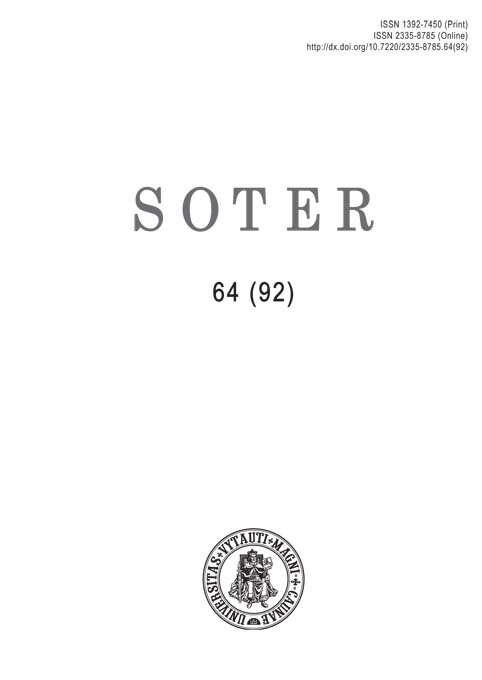Vyskupas Teofilius Matulionis – kapelionas „martyrium“ bendruomenėje
Bishop Tofilius Matulionis – Chaplain in the “martyrium” Community
Author(s): Aušra Vasiliauskaitė (Sr. Gabrielė OSB)Subject(s): Christian Theology and Religion, History of Church(es), Theology and Religion, Interwar Period (1920 - 1939)
Published by: Vytauto Didžiojo Universitetas
Keywords: bishop Teofilius Matulionis; chaplain; Martyrium; community; Benedictine sisters;
Summary/Abstract: In Lithuania this year, before the ceremony of beatification took place and Archbishop Teofilius Matulionis was declared a martyr on 25 June 2017 in Vilnius, a scientific conference “The Importance of Martyrium in the Life of the Church in the Context of Totalitarian Ideologies of the 20th Century” was held specifically in the honour of the Archbishop Teofilius Matulionis. One of the reports of plenary sittings addressed Bishop Teofilius Matulionis’ impact as a chaplain to the Benedictine community. Reminding the forgotten fact that Bishop Teofilius Matulionis was appointed to the Benedictine Sisters from 1936 to 1943 as a chaplain after various service, i.e. vicar, missionary, in places where he was not only a good listener for sinners, a prayer man, but also a manager, administrator. At the same time, he had already experienced the fate of a prisoner in two different places: Butyrka’s undergrounds and the Sokolniki Correction House, and eventually expelled to the Solovki Islands. That means Bishop Teofilius Matulionis was assigned to the Benedictine Sisters with a strong and magnanimous faith, with the experience of the test of faith. At that time, the existing Martyrium community, which was being restored after a break-up in Ciobiskis and Kaunas, was home to 13 sisters. Even with such a small number of nuns, the monastery still had internal problems. The jurisdiction there was unclear and not defined, material situation in the community was difficult due to debt, and the condition of monastery buildings was also poor. Therefore, it can be considered that the Benedictine Sisters community faced considerable challenges at that time. In the presence of Bishop Teofilius Matulionis, the Martyrium Community Chaplaincy experienced its golden age throughout a period of almost 400 years. The meaningful activities of the Sisters Benedictines of Kaunas were observed and evaluated in the society. Even during the difficult occupation era vocations did not stop, the girls responded to God’s vocation and chose a monastic life. As most of the families were impoverished due to war, not all the candidates were able to bring a dowry. Therefore, with the permission of Bishop V. Brizgius, it was decided to accept the candidates without a dowry also. Chaplain’s activity was a twofold spiritual renewal of the community. The first one concerned the liturgy of vows, which is the one related to monastic life, i.e. their rites, the revival of these rites. The second was the introduction of the Eternal Adoration of St. Sacrament by establishing the brotherhood of the Eternal Sacrament Adoration, not forgetting Mercy, every day praying in front a copy of the picture of Merciful Jesus. Restoring the church was carried by raising the remains of monks and re-burying them, by sanctifying the cross to commemorate the 500 years of Christening. Permanent adoration became the main feature of Benedictines’ spirituality in those days (except for the Saint Benedictine sisters of Kaunas), not only from other congregations, but also from all Benedictine communities. This adoration in the church of St. Nicolaus was temporarily interrupted only during the Soviet occupation. The spiritual life has been especially strengthened by the St. Sacrament adoration, which was some sort of compensation for active apostolic Benedictine activities. The adoration testifies to the fact that Benedictine sisters maintained the features of the contemplative monastery. St. Sacrament adoration was another feature of the Kaunas Benedictine Spirituality which cannot be found in any other Benedictine community. At the same time throughout the period when Bishop Teofilius Matulionis was a chaplain in the martyrium community, it is possible to distinguish the qualities of Excellency from the written and oral sources of the sisters: Greatly Honorable, All-Beloved, Holy Scripture, beautifully interpreting the greatness of the religious vocation and joy for the devoted souls, eloquent, able to persuade, everyone carefully followed the rites, emphatic, always saw God’s Providence, a lovely Father who was simple, calm, shining with his extraordinary authority, showing heartfelt respect, modesty. Dear Mother in a short speech expressed the joy of the monastery to His Excellency that he agreed to take on this rather difficult position – to patronize our monastery. His Excellency replied that he did not expect such a job, but, being requested by God, he took it, though timidly. The Blessed Archbishop Teofilius Matulionis was a man of God (cf. Gal 2:20) who worked a lot for the Catholic Church and Lithuanian society. The article presents a further unreported biographical detail – chaplaintion at the Benedictine Sisters Monastery of Kaunas. The merits for the Benedictine spiritual life of sisters are evaluated, emphasizing the life of the community at the time of the golden age when Bishop Teofilius Matulionis served and lived in the monastery. The study used unpublished archival sources and manuscripts of the Sisters stored in the Benedictine Archives.
Journal: SOTER: religijos mokslo žurnalas
- Issue Year: 92/2017
- Issue No: 64
- Page Range: 21-39
- Page Count: 19
- Language: Lithuanian

